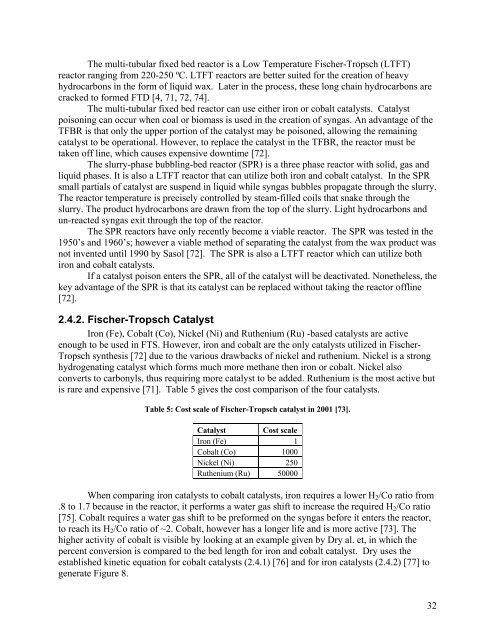Novel Design of an Integrated Pulp Mill Biorefinery for the ...
Novel Design of an Integrated Pulp Mill Biorefinery for the ...
Novel Design of an Integrated Pulp Mill Biorefinery for the ...
You also want an ePaper? Increase the reach of your titles
YUMPU automatically turns print PDFs into web optimized ePapers that Google loves.
The multi-tubular fixed bed reactor is a Low Temperature Fischer-Tropsch (LTFT)<br />
reactor r<strong>an</strong>ging from 220-250 ºC. LTFT reactors are better suited <strong>for</strong> <strong>the</strong> creation <strong>of</strong> heavy<br />
hydrocarbons in <strong>the</strong> <strong>for</strong>m <strong>of</strong> liquid wax. Later in <strong>the</strong> process, <strong>the</strong>se long chain hydrocarbons are<br />
cracked to <strong>for</strong>med FTD [4, 71, 72, 74].<br />
The multi-tubular fixed bed reactor c<strong>an</strong> use ei<strong>the</strong>r iron or cobalt catalysts. Catalyst<br />
poisoning c<strong>an</strong> occur when coal or biomass is used in <strong>the</strong> creation <strong>of</strong> syngas. An adv<strong>an</strong>tage <strong>of</strong> <strong>the</strong><br />
TFBR is that only <strong>the</strong> upper portion <strong>of</strong> <strong>the</strong> catalyst may be poisoned, allowing <strong>the</strong> remaining<br />
catalyst to be operational. However, to replace <strong>the</strong> catalyst in <strong>the</strong> TFBR, <strong>the</strong> reactor must be<br />
taken <strong>of</strong>f line, which causes expensive downtime [72].<br />
The slurry-phase bubbling-bed reactor (SPR) is a three phase reactor with solid, gas <strong>an</strong>d<br />
liquid phases. It is also a LTFT reactor that c<strong>an</strong> utilize both iron <strong>an</strong>d cobalt catalyst. In <strong>the</strong> SPR<br />
small partials <strong>of</strong> catalyst are suspend in liquid while syngas bubbles propagate through <strong>the</strong> slurry.<br />
The reactor temperature is precisely controlled by steam-filled coils that snake through <strong>the</strong><br />
slurry. The product hydrocarbons are drawn from <strong>the</strong> top <strong>of</strong> <strong>the</strong> slurry. Light hydrocarbons <strong>an</strong>d<br />
un-reacted syngas exit through <strong>the</strong> top <strong>of</strong> <strong>the</strong> reactor.<br />
The SPR reactors have only recently become a viable reactor. The SPR was tested in <strong>the</strong><br />
1950’s <strong>an</strong>d 1960’s; however a viable method <strong>of</strong> separating <strong>the</strong> catalyst from <strong>the</strong> wax product was<br />
not invented until 1990 by Sasol [72]. The SPR is also a LTFT reactor which c<strong>an</strong> utilize both<br />
iron <strong>an</strong>d cobalt catalysts.<br />
If a catalyst poison enters <strong>the</strong> SPR, all <strong>of</strong> <strong>the</strong> catalyst will be deactivated. None<strong>the</strong>less, <strong>the</strong><br />
key adv<strong>an</strong>tage <strong>of</strong> <strong>the</strong> SPR is that its catalyst c<strong>an</strong> be replaced without taking <strong>the</strong> reactor <strong>of</strong>fline<br />
[72].<br />
2.4.2. Fischer-Tropsch Catalyst<br />
Iron (Fe), Cobalt (Co), Nickel (Ni) <strong>an</strong>d Ru<strong>the</strong>nium (Ru) -based catalysts are active<br />
enough to be used in FTS. However, iron <strong>an</strong>d cobalt are <strong>the</strong> only catalysts utilized in Fischer-<br />
Tropsch syn<strong>the</strong>sis [72] due to <strong>the</strong> various drawbacks <strong>of</strong> nickel <strong>an</strong>d ru<strong>the</strong>nium. Nickel is a strong<br />
hydrogenating catalyst which <strong>for</strong>ms much more meth<strong>an</strong>e <strong>the</strong>n iron or cobalt. Nickel also<br />
converts to carbonyls, thus requiring more catalyst to be added. Ru<strong>the</strong>nium is <strong>the</strong> most active but<br />
is rare <strong>an</strong>d expensive [71]. Table 5 gives <strong>the</strong> cost comparison <strong>of</strong> <strong>the</strong> four catalysts.<br />
Table 5: Cost scale <strong>of</strong> Fischer-Tropsch catalyst in 2001 [73].<br />
Catalyst Cost scale<br />
Iron (Fe) 1<br />
Cobalt (Co) 1000<br />
Nickel (Ni) 250<br />
Ru<strong>the</strong>nium (Ru) 50000<br />
When comparing iron catalysts to cobalt catalysts, iron requires a lower H2/Co ratio from<br />
.8 to 1.7 because in <strong>the</strong> reactor, it per<strong>for</strong>ms a water gas shift to increase <strong>the</strong> required H2/Co ratio<br />
[75]. Cobalt requires a water gas shift to be pre<strong>for</strong>med on <strong>the</strong> syngas be<strong>for</strong>e it enters <strong>the</strong> reactor,<br />
to reach its H2/Co ratio <strong>of</strong> ~2. Cobalt, however has a longer life <strong>an</strong>d is more active [73]. The<br />
higher activity <strong>of</strong> cobalt is visible by looking at <strong>an</strong> example given by Dry al. et, in which <strong>the</strong><br />
percent conversion is compared to <strong>the</strong> bed length <strong>for</strong> iron <strong>an</strong>d cobalt catalyst. Dry uses <strong>the</strong><br />
established kinetic equation <strong>for</strong> cobalt catalysts (2.4.1) [76] <strong>an</strong>d <strong>for</strong> iron catalysts (2.4.2) [77] to<br />
generate Figure 8.<br />
32

















